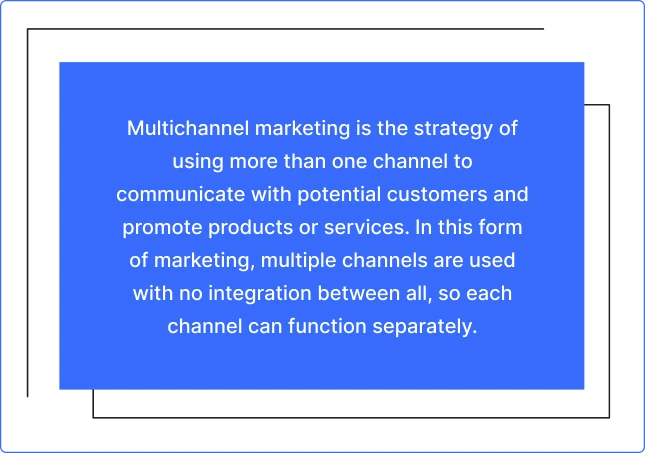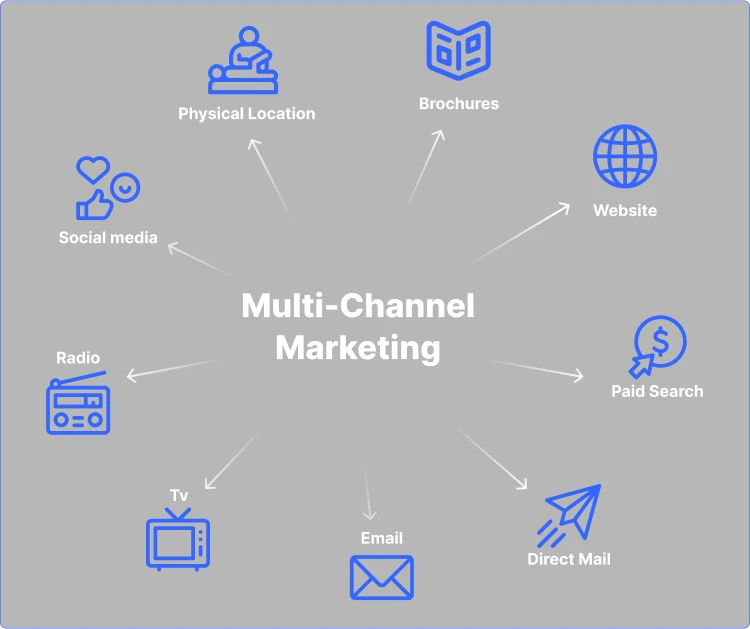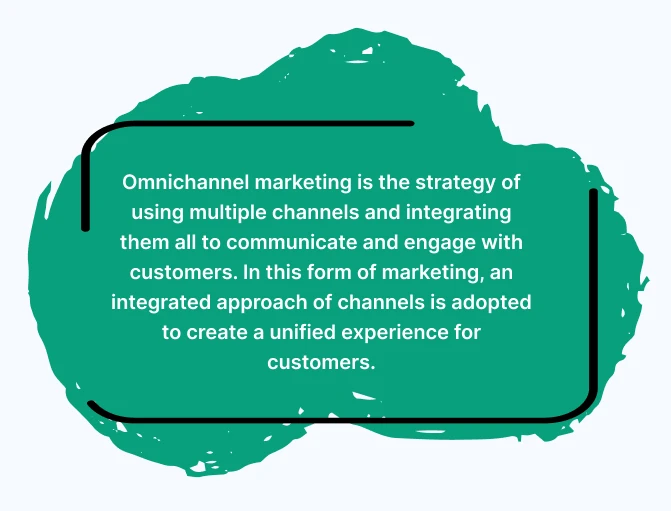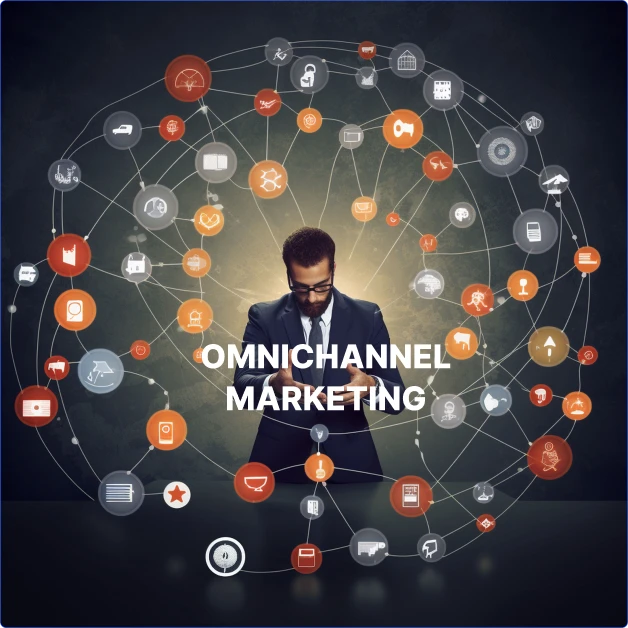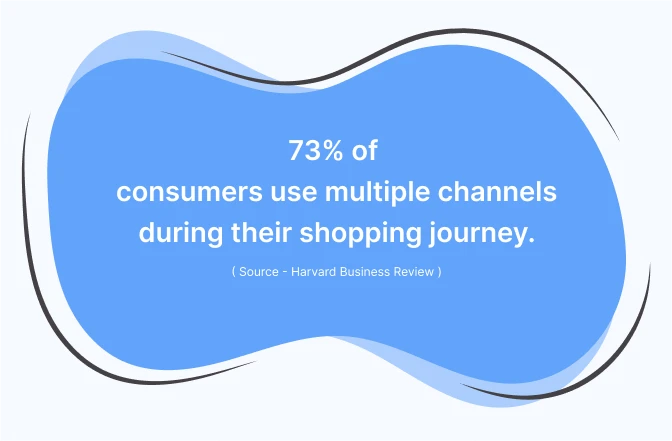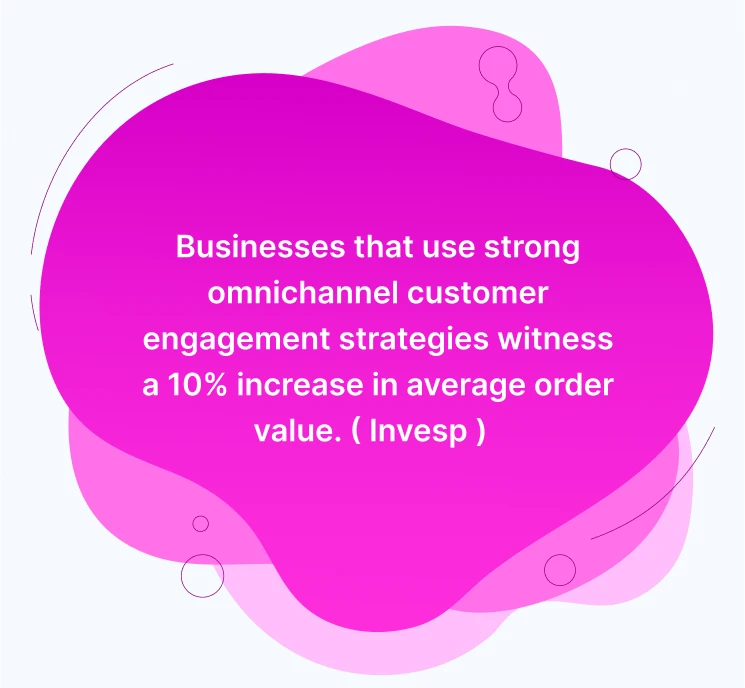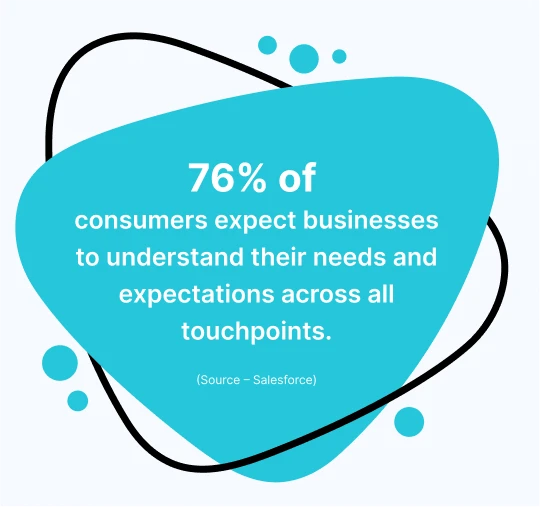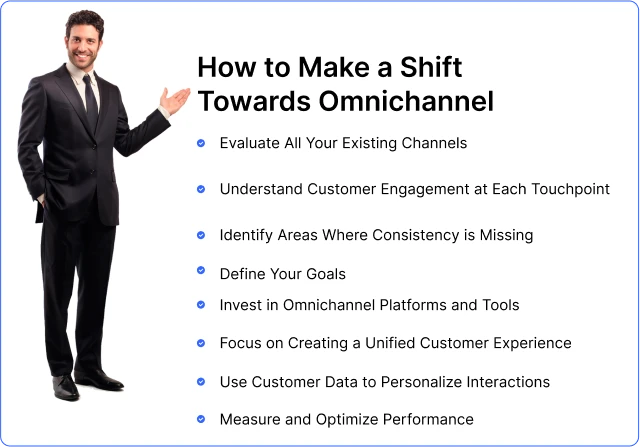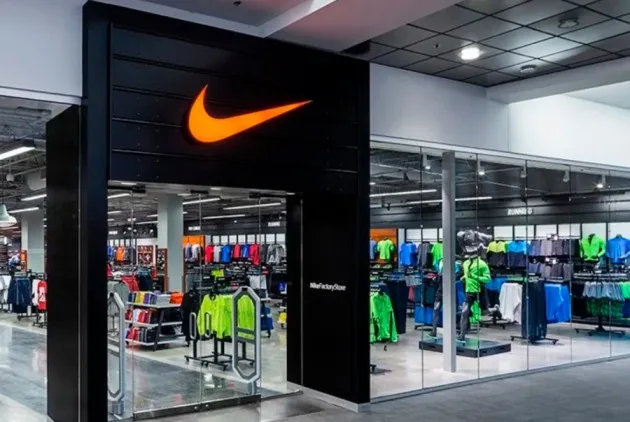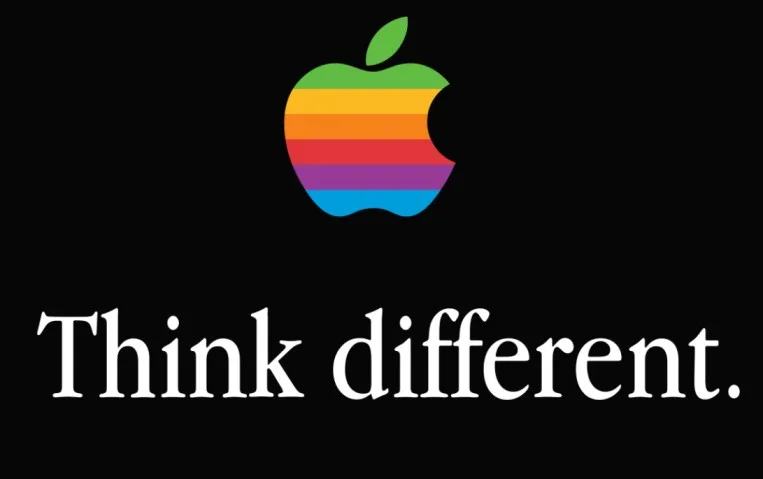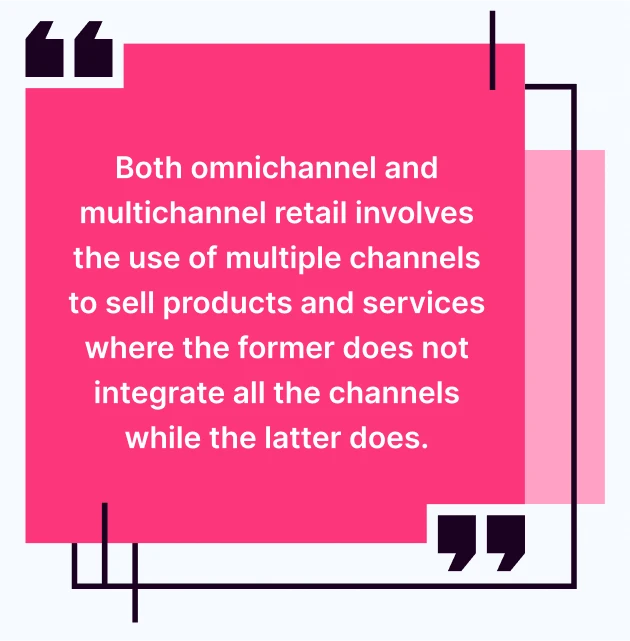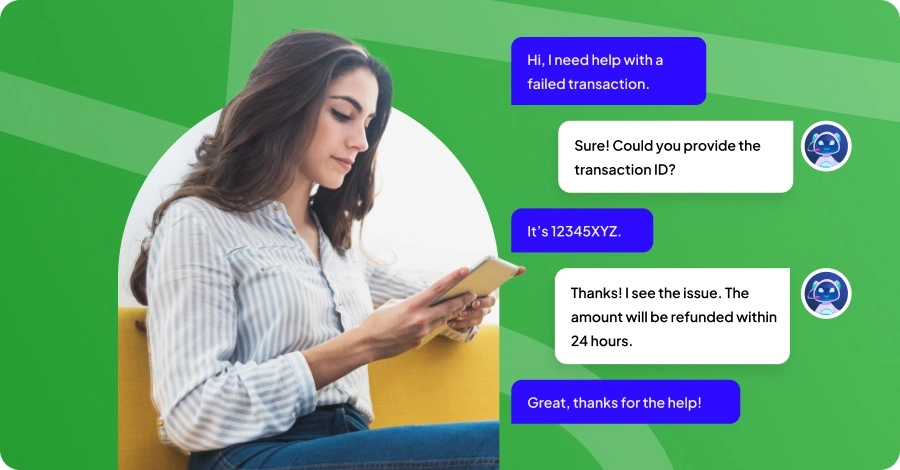Omnichannel vs. Multichannel: What is The Difference?
- April 27, 2020
- 19 mins read
- Listen
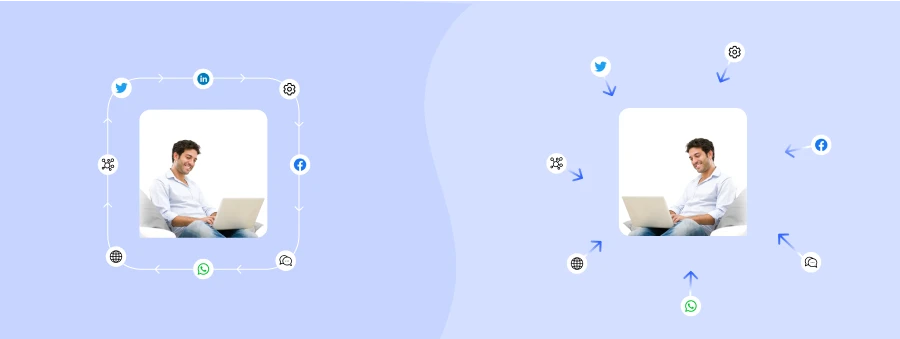
Table of Content
Some companies rely on a single marketing channel to reach their customers. This approach may have some benefits but it doesn’t fit well with today’s times. But why? Well, customers now want the flexibility to connect with businesses across channels. This same problem suggests there are differences between the omnichannel vs multichannel approaches.
Are both strategies the same or different? If yes, at what level? If not, what are the key differences between omnichannel and multichannel marketing?
Well, both are not the same and have distinct features. While both strategies involve the use of more than one channel to reach customers, multichannel does not integrate all the channels. On the other hand, omnichannel is interconnected in terms of channels and brings a holistic approach to marketing. A business can leverage either, depending on their unique needs, and achieve marketing goals.
In this blog, we will explore omnichannel vs multichannel in detail, understand how each works, see the differences, and also discuss other areas related to both concepts.
Before going further, let’s get started with the definitions first –
What is Multichannel Marketing?
Multichannel marketing is the strategy of using more than one channel to communicate with potential customers and promote products or services. In this form of marketing, both traditional and digital channels can be combined, to engage with the target audience.
From TV to print, social platforms to email, display ads to billboards, a multichannel marketing tactic can involve any number of channels as per the needs of the business. However, the multichannel marketing approach does not integrate all the channels.
Each channel can function separately in this type of marketing. With no integration, customers lack the flexibility to switch between channels. So, each of the channels can cater to a different audience.
How Does Multichannel Marketing Work?
Multichannel marketing is an effective way to engage with customers across multiple touchpoints and reach a wider audience. It helps boost brand visibility and drive conversion or sales. Marketers often leverage it to target consumers based on their unique behavior and preferences.
Let’s look at how multichannel marketing works –
- Marketers will first start with audience analysis with a focus on understanding the demographics and habits of their potential customers.
- Based on the analysis, the most effective channels are identified to reach the audience.
- Multiple channels are selected both from traditional media and digital platforms.
- Channel-specific content is developed to effectively cater to the requirements of the audience.
- The content ( which can take many diverse forms such as newspaper ads, social media posts, email newsletters, website text, etc. ) is then distributed across the selected channels.
- The content will lead to engagement and interaction, resulting in conversions and sales.
- The performance of each channel is tracked and measured against key metrics, and then used to optimize and refine the multichannel marketing strategy.
What is Omnichannel Marketing?
Omnichannel marketing is the strategy of using multiple channels and integrating them all to communicate and engage with customers. It’s similar to the multichannel approach in many ways, and the only key difference lies in its interconnected nature.
In this form of marketing, an integrated approach of channels is adopted to create a unified experience for customers. Since channels are connected, customers can seamlessly move through them and add value to their journey with your brand.
It’s a holistic approach to marketing focusing on creating a cohesive and consistent brand experience for customers. Businesses can use omnichannel marketing to deliver personalized experiences and successfully meet the expectations of today’s evolving consumers.
How Does Omnichannel Marketing Work?
Omnichannel marketing is an ideal strategy for businesses looking to engage customers better in an increasingly interconnected digital world. It fits well with the needs of providing a seamless experience to customers across their entire journey.
Let’s look at how omnichannel marketing works –
- Marketers will first understand the customer journey, the various touchpoints, and the channels where they can engage with their target audience.
- Interactions across channels are analyzed to gain insights into customer preferences and behaviors.
- The data gained from the interactions is used to understand the way customers engage with the brand.
- All the selected channels are integrated – both traditional and digital – so that customers can effortlessly transition through them without facing any issues in their journey.
- The focus is put on maintaining consistency in messaging and branding across all channels.
- Real-time communication and engagement is enabled with an emphasis on delivering tailored and frictionless experiences to individual customers throughout their journey.
- The performance is tracked, monitored, and measured against key metrics to optimize omnichannel marketing strategies.
Omnichannel vs Multichannel Marketing: What is the Difference?
Omnichannel and multichannel marketing may look similar on the surface but they have some marked differences that contribute to their effectiveness and relevance. All the differences they have can be used by businesses to engage customers better and boost their marketing ROI.
Let’s look at some of the key differences between omnichannel vs multichannel marketing –
1. Integration of Channels
The focus of omnichannel marketing is on integrating all the channels and offering a seamless and consistent experience across all customer touchpoints.
While multichannel marketing also involves the use of multiple channels, it does not prioritize integration.
2. Seamless Transition Between Channels
Since omnichannel maintains the interconnectedness of channels, customers can effortlessly move between the touchpoints without any disruptions, resulting in a smooth experience across the journey.
Each channel operates independently of each other in multichannel marketing. With no integration between channels, customers may experience disjointed experiences across the journey.
3. Approach or Focus Area
Omnichannel marketing puts customers at the center of every activity or interaction, so it takes a customer-centric approach through the channels.
In contrast, the product is the main focus area in multichannel marketing, so it adopts a product-centric approach through the channels.
|
Omnichannel Marketing |
Multichannel Marketing |
|
Channels are fully integrated and they work seamlessly. |
Channels are not integrated and each one operates independently. |
|
Customers can switch between channels without disruptions. |
Customers can’t transition between channels smoothly. |
|
A unified customer experience across all channels is delivered. |
Customer experience is not unified. |
|
Data and insights are shared across all channels. |
Each channel can use only a specific set of customer data and insights. |
4. Level of Integration
In omnichannel marketing, delivering personalized experiences is always the top priority. Marketers who use this form of marketing use customer data and insights to provide targeted messages tailored to individual behaviors and preferences. In essence, relevant marketing and promotions happen across all channels.
On the other hand, less emphasis is put on personalization when marketers use a multichannel approach. Messages and promotions are more generalized and less tailored.
5. Consistency in Branding and Messaging
When omnichannel strategies are adopted, the main focus is on maintaining consistency in branding and messaging across all channels. This is done to reinforce the brand image and boost customer relationships.
With multichannel marketing, less focus is put on the consistency of branding as each channel may have varying messaging.
Multichannel vs Omnichannel: Key Stats
Multichannel and omnichannel tactics are now used across industries with great results. If you’re not sure how effective they are, you can do some online research and easily find useful numbers substantiating their effectiveness.
Let’s look at key stats regarding multichannel and omnichannel strategies –
- 73% of consumers use multiple channels during their shopping journey. ( Source – Harvard Business Review )
- Multichannel shoppers have a 30% higher lifetime value compared to those who shop using only one channel. ( Source – Adobe Reserach )
- Businesses that use strong omnichannel customer engagement strategies witness a 10% increase in average order value. ( Invesp )
- 76% of consumers expect businesses to understand their needs and expectations across all touchpoints. ( Salesforce )
What are the Key Benefits of Omnichannel?
Today’s customers want the flexibility to engage with the business on the channel of their choice. They also want the freedom to buy from any channel or move between channels while making purchases. This is why omnichannel marketing fits well with the evolving needs of modern consumers.
Here are the key benefits of omnichannel marketing –
1. Higher Return on Investment (ROI)
Investing in an omnichannel marketing strategy means adopting an integrated approach across channels. This also means handling fewer touchpoints, understanding customers’ concerns faster, and providing effective solutions in the first go. This improves the first call resolution (FCR) metric and reduces the number of touchpoints.
Similarly, when customers receive quick feasible solutions with the right systems and technology in the first contact, the satisfaction level increases. It improves the lifetime value of the customer (CLTV) significantly, resulting in higher returns on investment (ROI) for the business.
2. Better Understanding of the Customer Journey
Your business can leverage an omnichannel customer engagement platform to unify all your customer conversations in one place and understand your customer journey better. It will help you personalize engagement with customers across all touchpoints.
Omnichannel communication also helps you be where your customers are. By being active on the preferred touchpoints of your customers, you can offer real-time engagement and improve customer experience.
3. Improved Customer Engagement Across Channels
When your business uses an omnichannel approach, it can better understand the customer needs and create strategies for engaging them better across all touchpoints. You can also know
the frequently used channels by your customers to connect with you. In addition, you can also be active where your customers are and deliver a great experience.
4. Deeper Insights into Customer Experiences
The omnichannel strategy helps to gain valuable insights into previous interactions by customers with your brand. Based on that, you can optimize your processes to reduce customer frustration, and also bridge the gaps in the processes, if any.
You can understand the major touchpoints where your customers need your assistance. Understanding all touchpoints will help you act proactively across the behavioral stages of the customers.
5. Enhanced Team Productivity
Generally, a lot of time is wasted in resolving a single issue by having many back-and-forth conversations with the customers. The omnichannel approach empowers your team with real-time feedback about customer interactions handled on each channel. Similarly, fewer touchpoints are involved in this form of marketing, resulting in less complexity in handling customer communication. All this results in improved overall team productivity.
6. Superior Customer Retention Rate
An omnichannel strategy connects all the channels and helps gain a better understanding of customer behavior. It also adds value by helping analyze customer journeys to deliver consistent support. What’s more, omnichannel customers are 30% more valuable to your business throughout their lifetime.
Brands that make the effort to engage their audience with an omnichannel tactic avoid attrition and leverage one of the best customer retention strategies. Omnichannel communication strategy empowers customers to connect with the brand through their preferred channel and also make a smooth transition in the same interaction.
7. Higher Levels of Customer Satisfaction
Customers often use a combination of online and offline channels like live chat, Facebook Messenger, kiosks, storefronts, or service centers to engage with businesses. Creating consistency across all channels improves the experience as well as the brand image.
Using this powerful marketing strategy, a business can connect with customers in real-time across their preferred channels and reduce the average response time. It can also improve customer satisfaction by analyzing their journey. All this will ensure higher levels of customer satisfaction for the business.
Omnichannel vs Multichannel: How to Choose
The choice between an omnichannel and multichannel strategy depends on various factors, the key being your marketing goals. What your target audience prefers and how much resource you are ready to allocate, are some other key considerations.
Let’s look at when should you choose a multichannel vs omnichannel approach –
When to Choose the Multichannel Strategy?
- When you want to utilize multiple channels to interact and engage with your customers but don’t want to integrate all the channels.
- When you’re looking to reach a broader audience and gain a presence across various platforms without achieving an interconnectedness of the touchpoints.
- When you have limited resources and you want to give customers flexibility in reaching you through their preferred channels.
- When you have a diverse target audience that prefers multiple channels for engagement.
- When you plan to invest in an integrated approach but first want to test different channels and see how they perform independently.
|
When to Use Multichannel Strategy |
When to Use Omnichannel Strategy |
|
When your business wants to reach a broad audience across various platforms without achieving interconnectedness of touchpoints. |
When your business wants to leverage multiple channels for marketing while maintaining consistency in brand messaging and customer experience. |
|
When you want to give customers flexibility in reaching you through their preferred channels, especially with limited resources |
When you want to enable customers to use multiple channels to reach out and switch between channels without disruptions. |
When to Choose the Omnichannel Strategy?
- When you want to provide customers with multiple channels to reach you and offer a seamless and integrated experience across all channels.
- When you want to leverage multiple channels for marketing but also want to maintain consistency in brand messaging and customer experience.
- When you want customers to use more than one channel to reach out and also have the freedom to switch between channels without any disruptions.
- When you aim to provide a cohesive brand experience across channels and boost customer loyalty to your brand.
- When you want to include multiple channels in your marketing mix and have the resources and capabilities for the integration of data and systems across touchpoints.
- You want to achieve high customer service and personalization to build stronger relationships with your customers.
Omnichannel vs Multichannel – How to Make a Shift Towards Omnichannel?
If the multichannel approach does not suit your business, you should consider switching to omnichannel. The switch however will not be easy and involve careful planning and investment in tech infrastructure. The real challenge of such a transition lies in the integration of all channels seamlessly.
Here is a step-by-step guide on how to transition from a multichannel to an omnichannel marketing strategy –
Step 1 – Evaluate All Your Existing Channels – You first need to evaluate all your existing channels.
Step 2 – Understand Customer Engagement at Each Touchpoint – Make sure you understand how your customers engage with your business at each touchpoint.
Step 3 – Identify Areas Where Consistency is Missing – Check if your customers are getting a smooth experience at each stage of their journey with your brand. Find out areas where consistency is missing in terms of integration between channels or customer experiences.
Step 4 – Define Your Goals – What prompts you to make a switch from multiple to omnichannel? Do you want to drive conversions, or boost customer experience? Be specific in your goals as it helps achieve better results.
Step 5 – Invest in Omnichannel Platforms and Tools – First you need to evaluate your tech infrastructure and see the gaps existing between touchpoints. Based on that, consider investing in omnichannel platforms and tools.
Step 6 – Focus on Creating a Unified Customer Experience – Allocate resources for achieving consistency in brand message and customer experience across all touchpoints.
Step 7 – Use Customer Data to Personalize Interactions – The real hallmark of an effective omnichannel strategy lies in providing personalized communication based on customer behavior and preferences. For this, you need to leverage customer data and insights.
Step 8 – Measure and Optimize Performance – You also need to continuously track, monitor, and measure the success of your omnichannel strategy against popular KPIs.
Multichannel and Omnichannel Examples
Nike’s Powerful Multichannel Marketing Approach
Nike commands worldwide respect for many reasons, one is its effective use of a multichannel marketing approach. The global athletic footwear and apparel brand uses a combination of channels such as physical stores, e-commerce, social media, and sponsorships with great effect. While its flagship stores offer immersive brand experiences, it also takes care of convenience and accessibility through ecommerce platforms. The way it uses social platforms for engagement and brand promotion and its sponsorships of top sporting events add to its multichannel marketing strategy.
Apple’s Subtle Integration of Multiple Channels for Marketing
Apple is another brand that gets its multichannel marketing strategy bang on target as it knows how to effectively fuse multiple channels for great impact. Its retail stores exceed customer expectations by offering immersive experiences and personalized assistance. Its e-commerce website gives customers another channel to access and purchase products comfortably. Apple’s marketing campaigns generate tremendous visibility and engagement as they span across multiple channels including TV, print, digital and social. With interconnected devices and services, the company can run an effective multichannel marketing strategy with excellent results.
Disney’s Highly Effective Omnichannel Approach
Disney is a great example of how to use omnichannel marketing to maximize impact and deliver a unified experience to customers at all touchpoints. The way it seamlessly integrates various channels including theme parks, merchandise, and movies, is noteworthy. Guests are always guaranteed an immersive brand experience across channels whether they visit one of its theme parks, resorts, retail stores, online platforms, or streaming services. It lets guests plan and customize their vacations using the “My Disney Experience app”. More so, its omnichannel experiences cut across audiences of all age groups, and also extend beyond digital platforms.
Lululemon’s Personalized Touch to Omnichannel Marketing
Athletic apparel brands offering personalized experiences are nothing new but the way Lululemon does creates a lasting impression. Its omnichannel strategy integrates diverse channels including online stores, social channels, mobile apps, and physical stores, and all together ensure a seamless experience. It gives customers the option to browse products on the web, visit nearby stores to check availability, and make purchases through their preferred channel. The standout aspect is the in-store pickup, curbside pickup, and above all, a home delivery. When customers use its mobile app, they not only get personalized product recommendations but also virtual tools for try-on.
Omnichannel vs Multichannel Retail
Retailing is advancing at a rapid pace. Retailers today realize the value of using multiple channels to sell their products and services. This need has fuelled the growth of omnichannel and multichannel retailing. Both are unique approaches with some key differences.
Let’s look at how omnichannel retailing is different from multichannel retailing –
Multichannel Retail
- The multichannel retail model involves the use of multiple channels to sell offers.
- The channels involved can be a combination of traditional and digital mediums, such as physical stores, online stores, social channels, websites, mobile apps, and more.
- In multichannel retailing, channels are not integrated and each of them works independently with its specific selling strategies for the target audience.
- While customers can have the flexibility to buy from among different channels, they won’t transition from one channel to another.
Omnichannel Retail
- The omnichannel retail model also uses multiple channels for selling and has a seamless integration between those channels.
- Unlike multichannel retail, in this type of retail, buyers can get a unified experience regardless of the channel they
- With omnichannel retailing, buyers can begin their shopping journey in one channel and continue it in another in a seamless manner.
- In this form of retail, buyers get consistency due to the integration between different elements such as inventory management systems, customer databases, and other processes.
- The focus of omnichannel retail is just not to sell but also to offer buyers a consistent brand experience at all touchpoints.
Multichannel vs Omnichannel Ecommerce
More customers buy products or services online today than they did earlier. The easy accessibility and convenience of shopping are key factors driving the growth of the ecommerce industry. However, in recent years, e-commerce businesses have realized the need to streamline their sales processes so that customers find it easy to buy.
With more people using a combination of online and offline channels for making purchases, ecommerce sites had no option but to leverage multichannel and omnichannel approaches. So, gone are the days when using one channel was enough to get the sales rolling. Today, an ecommerce business needs multiple channels to sustain itself in the market.
By using multiple channels, an ecommerce business can give more options to buyers and that can result in a boost to order rate. Similarly, with omnichannel ecommerce, multiple channels can be used with an interconnected approach between them to ensure a seamless experience for customers.
Omnichannel vs Multichannel Customer Service
Customers are quite evolved today. They want the freedom to engage with businesses on their terms. With expectations of customers growing, customer service needs to adjust to the changed times.
Using a single-channel support strategy no longer works. After all, it can’t give customers the flexibility to use different channels for assistance. Multichannel customer service does that. However, it also won’t allow using different channels in separate interactions.
On the other hand, omnichannel customer service works by integrating multiple channels so it ensures a smooth support experience. It allows customers to get service on their preferred channel whether they want it on live chat, social channel, phone, or email.
The best thing, customers can switch to other channels in the middle of an engagement without any disruptions. This kind of seamless support experience is made possible when an omnichannel approach is available.
Final Thoughts
In a nutshell, the objective of both omnichannel and multichannel marketing strategies is to reach potential customers across multiple channels. With the ever-growing customer expectations and technological advancement, it has become imperative for businesses to consider a shift from a single to a multichannel strategy.
With REVE Chat, your business can drive the rate of engagement through advanced tools. We can help you engage with your customers across channels by using our AI-powered chatbot and live chat software.
You can sign up with us and check how our tools can add great value to your business on many levels.

